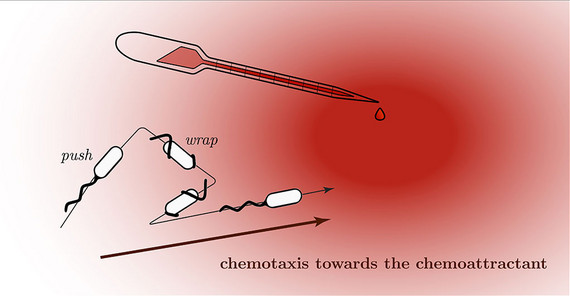Elucidating the principles of bacterial motility and navigation is key to understand many important phenomena such as the spreading of infectious diseases. Swimming bacteria are pushed forward actively by rotating helical flagella, interrupted by random tumbling events, when the flagella change their sense of rotation. Using Escherichia coli as an example, it was shown that bacteria can navigate to a food source by regulating the frequency of tumbling.
In contrast to E. coli, other bacteria exhibit several distinct run modes that differ in the arrangement of flagella, as observed by Potsdam researchers within the Research Training Group „Nonequilibrium Collective Dynamics in Condensed Matter and Biological Systems“ and the Collaborative Research Center „Data Assimilation“. The physicist Zahra Alirezaeizanjani and her colleagues addressed the role of run modes for the foraging dynamics of bacteria using the soil bacterium Pseudomonas putida as model organism. They designed and constructed a dedicated microscopy setup to record alternating sequences of phase contrast and fluorescence images of bacteria. To their surprise, they found experimental evidence that these run modes are distinct behavioral states that differ not only in their motion characteristics, such as their speed, but also in their responsiveness to concentration gradients in the substances.
These results shed new light on how bacteria purposefully navigate — a first step to understand more complex chemotaxis strategies of bacterial swimmers beyond the well-known paradigm of E. coli. This research opens the door towards future experimental studies that will increasingly focus on motility and chemotaxis in complex environments. Moreover, the findings regarding search strategies may find applications in the design of artificial micro swimmers or autonomous robots.
Link to publication: Z. Alirezaeizanjani, R. Großmann, V. Pfeifer, M. Hintsche, C. Beta: „Chemotaxis strategies of bacteria with multiple run modes.“ Sci. Adv. 6 eaaz6153 (2020). https://doi.org/10.1126/sciadv.aaz6153
Image: Schematic representation of a bacterium with two motility modes, push and wrap, swimming towards the source of an attractant. Image: Dr. Robert Großmann.
Contact:
Prof. Dr. Carsten Beta, Institute of Physics and Astronomy, Tel.: +49 331 977-5651, biophysuuni-potsdampde
Dr. Robert Großmann, Institute of Physics and Astronomy, Tel.: +49 331 977-5722
Zahra Alirezaeizanjani, Institute of Physics and Astronomy, Tel.: +49 331 977-5722
Media Ininformation 29-06-2020 / Nr. 068

